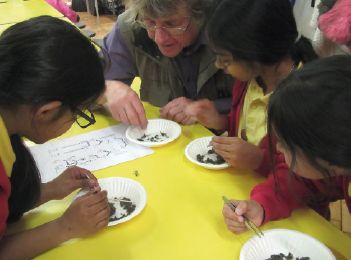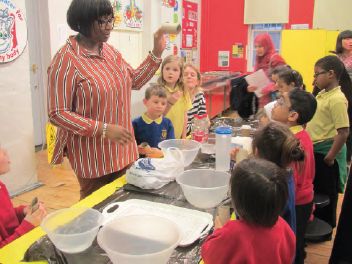
Physiology News Magazine
Public Engagement: Eat. Poo. Sleep.
News and Views
Public Engagement: Eat. Poo. Sleep.
News and Views
Sai Pathmanathan
Science Education Consultant and Public Engagement Grant Awardee
https://doi.org/10.36866/pn.102.10
It’s been a while since I’ve written for Physiology News… some of you might remember me…I used to work at The Society over a decade ago! I’ve since been working in science communication, and was thrilled to find that I was eligible for a Physoc Public Engagement Grant.
Last November, we kicked off the first of a set of events called, ‘Eat. Poo. Sleep.’ The project aims to get families thinking about how our bodies work, in particular the physiology of digestion, defecation and snoozing. Why DO we need to eat, poo and sleep? And what happens if we don’t do any of them?
The disgusting bodily functions of humans and animals have been shown to be extremely engaging in outreach (e.g. ‘Snot, Sick and Scabs’), children’s media (e.g. Operation Ouch) and health-edutainment programming (e.g. Embarrassing Bodies). This project idea came about following past outreach events where young children were interested in how their bodies work, and all the ‘icky stuff’ that goes on inside them.
The emotions elicited by ‘gobbling’, ‘slurping’, ‘pooing’ and ‘snoring’ can help audiences commit the science embedded within the humorous and disgusting aspects, to memory. Whilst we’re not trying to produce formal learning events, the informal learning can, for example, help young people with curriculum science (‘Living Things’) as well as help adults learn about nutrition and what happens in our brains when we sleep.
And it’s not only the ‘ick factor’ that acts as a hook. By involving storytellers and musicians, alongside practicing scientists, this offers the element of arts/science-integration that not only attracts those not usually interested in science, but allows those who are interested, to appreciate the arts as useful tools for creative communication.

This first event took place at a primary school in East London, and four main, drop-in style workshops were set up. Jonathan Forgham (my old primary school teacher, who now runs The Primary Works consultancy), ran an ‘EAT’ session on dissecting owl pellets. As humans, we might just vomit or excrete anything we can’t digest, however, owls cough up a pellet. By carefully teasing these pellets apart, participants could find out what the owls had eaten: fur, bones and insect wings. Finding a mouse skull seemed to be quite amusing for some kids (though probably not for the mouse). One parent commented that it was the most engaged her son had ever been, and took away some owl pellets to dissect with her son later. This activity linked in well with the sleep activities, as owls are nocturnal hunters.
David Urry, from the Natural History Museum, brought along his ‘entomophagy’ exhibit i.e. edible bugs, with specially prepared cricket fritters, and mealworm cookies – for everyone to try. Being a vegetarian, I just couldn’t, but most of the children and their parents had a try!
This activity linked well with the owl pellets… i.e. in the future, could our diets become more similar to that of other species? By 2050, we’ll need to feed two billion more people. One of the options for solving the world’s food shortage and ensuring that we have a sustainable source of nutrients is for us to start eating insects. There is 19-26 g of protein and 6 mg of iron per 100 g of beef. Which is about the same as 100 g of grasshoppers. David ended the event with his hilarious song, ‘Stick It In Your Mouth’, with everyone joining in with the catchy chorus.
The ‘POO’ activity involved talking participants through a digestion model (kindly delivered in person by Anisha and Angela from the Physoc office), followed by some messy hands-on activities with Amara Anyogu, a microbiologist from London Metropolitan University. Tights were used to simulate intestines, with pretend food (eventually turning into fake poo) in the form of loo rolls. Amara was also able to speak about the trillions of microorganisms in our intestines that help in digestion, a lot of which ends up in our faeces.
Unfortunately, Nicola Davies (children’s author and one of my favourite wildlife presenters when growing up) couldn’t be with us for this particular event, but her book Poo was available for everyone to peruse. It was popular amongst the crowd (I did worry that I might not get it back), as it contains ‘revolting, embarrassing and very important’ information, such as the different types, colours and consistency of animal poo, and facts like how orang-utans have the smelliest poo, especially after eating durian fruit. Definitely worth a read.
I ran the ‘SLEEP’ section, and this was also a chance to do more Reaction Ruler experiments and test everyone’s reaction times based on tiredness (rather than age). One group of children and adults started to get into complexities of the brain – a whole conversation on the Broca’s area and language – which was fine for me, having a neuroscience background, but this is one of the reasons such events need more experts on hand. Anyone can communicate science, but only experts can answer specific questions. We also covered contagious yawning, brain cooling and the hormone of darkness, melatonin.

Previous family workshops have shown that parents appreciate the need for experts to help explain the basic science to them and their children, so that they may follow up with their children later. For example, a parent recently commented: ‘I would like my kids to do more science-based activities because we are not a very ‘scientific’ household.’ This resonates with the ASPIRES findings that ‘science capital’ is an important factor in what draws young people to science. In all family events, parents push their children to the front, but it’s obvious that parents are the ones who want to know more, ask questions and have their doubts alleviated. Parents even said they fought over who could leave work early to take the kids to the ‘Eat. Poo. Sleep.’ event.
These current ‘Eat. Poo. Sleep.’ activities are not brand new. They have been altered slightly to make them easier to replicate by parents and primary teachers, and we have provided activity sheets, which are available for Physoc Members too, to use during British Science Week and other national events.
And there are more activities to come. ‘Eat. Poo. Sleep.’ is such an all-encompassing theme: we could discuss hunger hormones, obesity, sleep disorders…the list is endless. And the more Physoc Member expertise we can involve, the better. Funding is always nice, but support is even lovelier. Especially for lone freelancers like myself. The final set of resources generated will be presented in a free e-book.
Now, the hope is that more drop-in, family events will take place in 2016, as part of various festivals around the country. But with certain conditions. The festivals MUST NOT be science festivals and must reach new audiences, in order to be more equitable.
By taking activities to where the people are – to cheap or free events that they are likely to frequent (village fetes, county fairs) – they can get a free science experience too. Experiences like these need to be available to ALL. Many of the parents at our event were first generation immigrants, some not speaking much English at all. As an afterschool session, if children come, parents, grandparents, aunts, and uncles come too. It’s a safe place, not intimidating and they know how to get to the venue and how to get back home with no issues. It’s not easy for everyone to go to a science museum or discovery centre, especially if fees and travel are involved.
I would like to thank Jonathan, David and Amara, Physoc Member, Lizzie Hill for her expertise on the ‘SLEEP’ elements, and particularly the Physoc Public Engagement team, Chrissy Stokes, Angela Breslin and Anisha Tailor for all their help and advice.
To find out more (and how to get involved), contact me on aloha@saipathmanathan.com or drop Anisha Tailor a line in the Physoc office (atailor@physoc.org). And for more information about the grants: http://www.physoc.org/public-engagement-grants.

